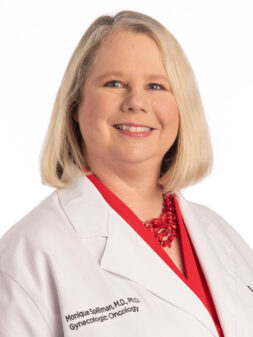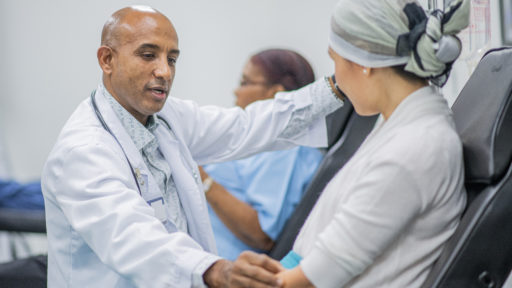Description
In this Conquering Cancer segment from THV11, Karen Fuller speaks with DeAnn Shields-Marley, who shares her 16-year journey of overcoming ovarian cancer. With the guidance of Dr. Monique Spillman, a gynecologic oncologist at UAMS Health, they discuss the challenges of detecting ovarian cancer early and the critical need for awareness and funding for research.
Video Player
Transcript
Karen Fuller:
Many women are aware of breast cancer and the color pink associated with it. But today, the color teal is being worn to bring needed attention to ovarian cancer.
In our Conquering Cancer series, why this cancer is far less common but more deadly.
DeAnn Shields-Marley only visits the UAMS Winthrop P. Rockefeller Cancer Institute once a year now for a checkup. She is 16 years out from a successful fight against ovarian cancer. Her survival rate is something that was once considered impossible.
Shields-Marley:
That’s because it was a death sentence. And maybe at the most two years. So I’ve had a will drawn up and and all of those things.
Fuller:
Dr. Monique Spillman is a gynecologic oncologist at UAMS and a professor. She says there are still no screening tests for ovarian cancer, and that’s what makes early detection so challenging.
Monique A. Spillman, M.D., Ph.D.:
We teach our students to listen to our patients, to screen for these types of symptoms, and to think about ovarian cancer early, rather than just saying it’s a urinary tract infection.
Fuller:
Ovarian cancer begins when abnormal cells in a woman’s ovaries or fallopian tubes grow and multiply out of control. According to the American Cancer Society, in 2024, nearly 20,000 women will be diagnosed with ovarian cancer and just under 13,000 will die from it.
Dr. Spillman:
The most common stage of ovarian cancer is stage 3 or 4, and it’s because it presents with the symptoms of bloating and trouble eating when you already have fluid inside the belly, or when you already have a disease that’s outside the ovary.
Shields-Marley:
I had been gaining belly fat. Nowhere else did I gain weight. So I took this over-the-counter thing that is supposed to make you get rid of that belly fat? I took a month to have it and nothing was happening, so I couldn’t zip up my pants.
Fuller:
DeAnn finally saw a gastroenterologist who sent her for a scan. From there, she began a whirlwind of surgery and chemotherapy at UAMS, and it was only in the recovery room that she learned exactly what she was up against.
Shields-Marley:
And he said, “We kept you up and as long as we could” — you know, five or six hours. He said, “But you’re still completely covered,” from, you know, under my breast all the way down with rice-sized cancer cells.
Fuller:
DeAnn began the chemotherapy to try and rid her body of those cancer cells. While at the height of success as a professional photographer specializing in architecture. Still sick from the treatment, DeAnn’s unwillingness to quit earned her an award with a shot published on the cover of a national fire magazine. She knows now she’s among the lucky few whose disease did not come back, as it so often does with ovarian cancer. To newly diagnosed women, she offers this advice.
Shields-Marley:
Hang in there. Don’t give up. You can give up easily, but just don’t give up. I mean, it’s getting better all the time — the treatment.
Fuller:
Because it’s less common, ovarian cancer research receives less funding. One source is a long-standing Department of Defense add-on bill. But overall funding is only one-tenth of what other cancers receive.
Hayden Balgavy:
And these symptoms, they are very vague.
Fuller:
Very vague. And so for that reason, there’s an acronym for the symptoms called BEAT — as in beating cancer. Bloating; eating, but feeling too full too soon; abdominal pain; and “T,” trouble with urination or sensing a need to use the bathroom more often. But yeah, more and more advances are being made. It is survivable more than it used to be.
Balgavy:
Good. Good deal. More attention to it.
Fuller:
Yes, exactly. And today’s a good day.





